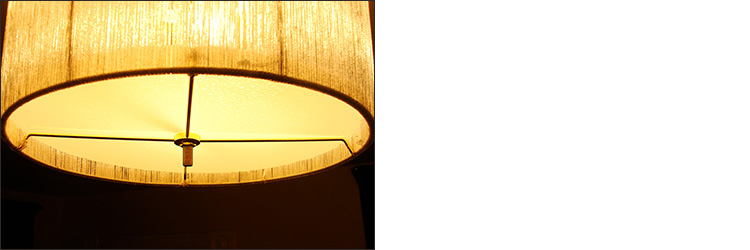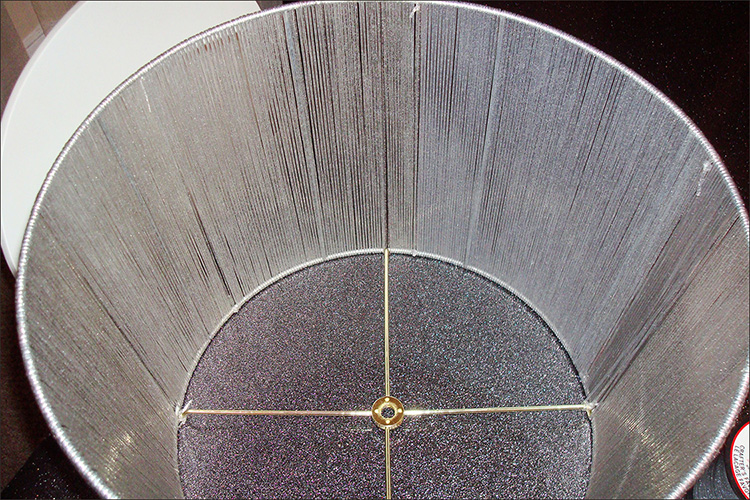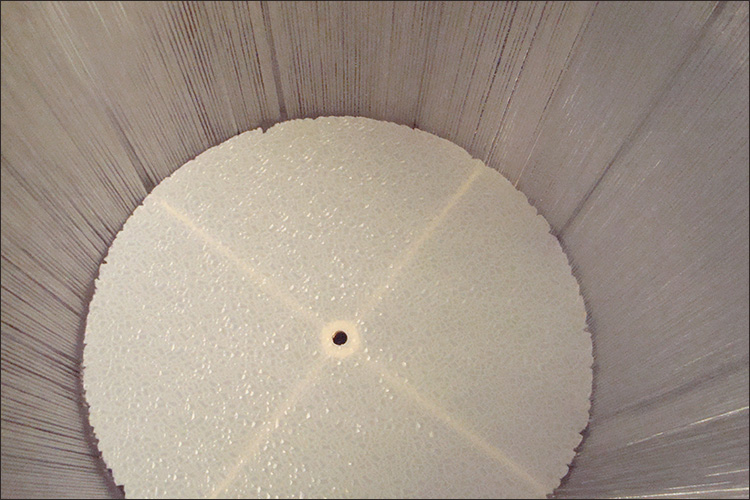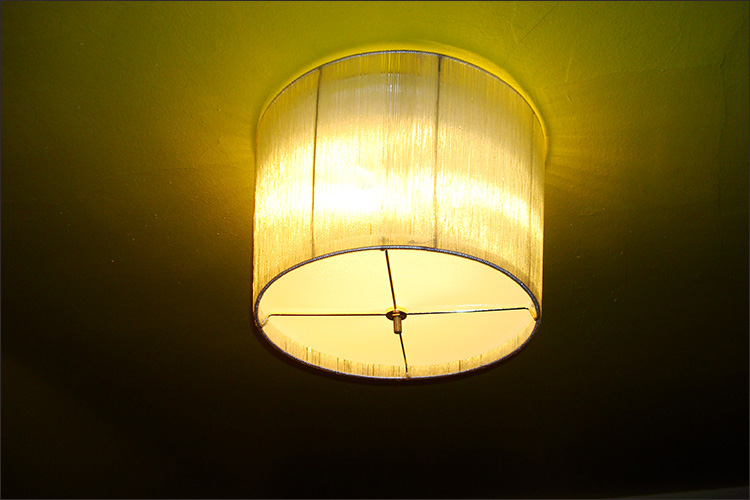See the light!

Here goes nothing…
as this is my first attempt at blogging, so bear with me. But I think this is a good one to start off with, so: I am so sick of the quintessential Home Depot light that has been a feature of nearly every rental I have lived in over the last 12 years and I finally decided to do something about it. Read on if you feel my pain…
You know the light I am talking about… a half globe that has a center post that screws into the ceiling that might set you back about $10. I understand, from a property owner’s perspective, its a solid choice. But seeing it glowing from my ceiling, night after night, year after year, apartment after apartment, it’s time for a change. But keep in mind, I live in an older rental, which means 2 things: the wiring is a way out of date, so changing out a hardwired light might not be in my best interest and I also don’t want to spend a whole lot of money because I might not need it in the next apartment I live in.
Where does that leave me?
After doing extensive research and many hours shopping, I could not find anything that I thought would work to switch out the light without messing with the wiring too much. And adding to the challenge, my ceilings are on the lower side and good design can be expensive (especially when talking lighting.)
So, I decided to make something on my own. Not going to lie, I was inspired by the violin string table lamps that I had purchased years ago at Target, which sadly are no longer available. I racked my brain for something that could be used as the string without being so tedious and still translucent enough to light up the room. Hmm, I vaguely remember something I referred to as “gimp” as a child. Plastic lacing maybe? I found it at both the Michael’s and AC Moore. Low and behold, it came in clear with specks of glitter. There were other translucent options which I want to try in the near future, but I needed as much light as possible for this light (something to keep in mind, the pink translucent will color the whole room pink, which could be cool…but probably not that practical for the only light in the room). The spools were pretty large and not that expensive ($5? The whole project eventually took 3 spools, which I would recommend buying all at once, you can always return extra spools…)
After a quick trip to Homegoods to find as close to a straight sided drum shade as I could find (patience is not a virtue of mine), I was off and running. I stripped the shade of its beige pleated glory and went to work. One tip? Make sure you’re buying a shade that will retain its structure even after the fabric is gone. There were a few that seemed to be held together by the fabric. What I ended up with was two rings that had 4 support posts running between them to hold the shape. Perfect.
I started wrapping the gimp around the frame, running parallel to the supporting posts. And then I of course ran out of gimp. After that slight set back and another trip to the store, I was wrapping again. (I think I bought a different brand that actually was a slightly different color, which you can see in the picture. Not terribly noticeable, but more than enough reason to buy way more than you think you will need to avoid this design flaw.) It took awhile, but it looked pretty cool once I was done and I was only out about $27 so far, including the shades.
Now, how to hang?
My original idea was to drill eye hooks into the ceiling to suspend the shade as close to the ceiling as possible. As luck would have it, the lampshade that I purchased had a hole in the center (normally used to put the shade on a lamp). I figured out that if you turned the shade upside down, it could be attached in the same way that the existing lamp cover was attached, all I needed was a longer threaded rod. So, off to the Home Depot… I wandered around looking at different threaded rods all over the store and found something that I thought could work. And then, some angel wearing an orange apron must have wondered what I was up to and intervened. Came to find out that back in a remote corner of the big orange box was a whole section of odds and ends devoted to people making their own lamps + lights. There it was, the answer to my problem. A longer threaded rod meant for lighting! Who knew? Anyway, it was perfect.
Looking for a cover…
The next challenge of this project was to find something to put in so that you couldn’t see the skeleton light fixture + bulb while standing (or laying) underneath the light. Home Depot to the rescue again. They sell the translucent material that goes into fluorescent light fixtures by the sheet. My Home Depot buddy told me that I could use strong shears to cut it into a circle but that it is a very brittle material and would splinter while cutting it in a circle. (I am sure straight lines would be much easier). He was right, the edges were all cracked, etc. But I pressed on. I figured as long as I could push the translucent material down to rest on the frame of the lampshade that the edges would be concealed. For the most part, I was right.
Then the hole…
The final challenge in this project was how to get a hole in the center of this fragile plastic disc without shattering the whole thing. This one was not solved by a Home Depot guy (probably because I hadn’t thought that far yet…) but instead by my own genius roommate. I have to be honest, I had my doubts about this working, but it couldn’t have worked out better. He had the idea to heat up the end of the new metal threaded rod using the gas burner on the stove. When it was hot enough, we just put the plastic on a thick piece of wood and melted our way to a perfect hole in the center of the plastic. No shattering at all. (just make sure you use gloves. The rod obviously gets pretty warm.)
The last part I knew would be the worst. It wasn’t difficult, just time consuming. I had to cut the new threaded rod to the exact length I needed. I had a small hacksaw laying around from another project, so I went to work. It took awhile, but eventually it cut through. (it is a hollow, afterall…)
So, onto the install…
I took down the dreadful rental light cover, leaving the rest of the light fixture there. Switched out the existing threaded rod for the new custom length. Flipped the shade so that the top part is now on the bottom and pushed the translucent material down to the metal cross and hole. Placed the shade against the ceiling until some of the threaded rod is through the new shade and then twisted the nut from the original fixture on to hold it all in place.
Turned on the light. (I did have some problems with installing the light given that my ceilings aren’t perfectly smooth, so adjustments had to be made so light didn’t spill out the top, etc.
But I will recommend using the energy saver bulbs, for a few reasons: of course its better for the environment, but it also means you won’t have to dismantle it to change the bulb any time soon (those things supposedly last 20 years?) and there’s less heat given off. (I was a bit nervous about the heat from the bulbs and the plastic lacing, but its been up for almost 6 months now and I have not seen any indication of a problem.)
So: lamp shade $12, gimp $15?, new threaded rod $5? sheet of translucent material $8? At most? (I am just guessing about the prices). So, approximately $40 and one well-planned afternoon. Banishing the rental light to a closet until move-out day? Priceless.
I liked this so much, I did another one for my craft room and I have plans to do one for our living room once I find a shade large enough.
Good luck with your lighting project. Feel free to contact me if something isn’t clear…











A brief trip down memory lane. Love it all. Mom